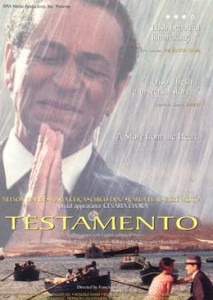
O Testamento Do Senhor Napumoceno (Napumoceno's Will) 1998
Distributed by California Newsreel, Order Dept., PO Box 2284, South Burlington, VT 05407; 877-811-7495 (toll free)
Produced by Francisco Manso
Directed by Francisco Manso
VHS, color, 110 min. Portuguese with English subtitles
Adult
African Studies
Date Entered: 11/09/2018
Reviewed by Gloria Rohmann, Electronic & Media Resources, NYU Libraries, New York UniversityA provincial town in the arid Cape Verde Islands off the coast of Africa is the setting for this bittersweet farce about love and lost opportunities. The death of Don Napumoceno da Silva Araujo arouses feelings of grief and celebration through the town. His nephew, who stands to inherit the lifelong bachelor’s substantial “import-export” (read “smuggling”) business, rejoices. His pensioned-off former servant, Mari Chica, who has raised their illegitimate daughter, Graca, on the other hand, fears the loss of her livelihood. But in one of those reversals of fortune so common to provincial bourgeois farce, it is revealed that Araujo has left his entire fortune to his heretofore-unacknowledged daughter, Graca. He also leaves her a stack of audio cassettes, on which he has recorded the story of his life, which is dramatized in a series of flashbacks.
The music, composed and performed in the traditional Cape Verdean morna style by World Music star Tito Paris, is a distinctive feature, as is the all-too-brief appearance by popular Cape Verdean singer Caesaria Evora. The film provides a glimpse of the hierarchical and complex creole society of Cape Verde that is at first interesting, but ultimately becomes tiresome. Although the town is picturesque, the arid landscape and desolate beaches of the island add to the film’s claustrophobic effect. Not enough happens in the inner or outer life of the characters to justify the film’s 110 minute length. Lines are delivered in elegiac whispers or in a stilted, old-fashioned European cinematic style—characters laugh too loud, or are pop-eyed and gape-mouthed in grief or anger.
Despite these drawbacks, the unusual setting of the film may make it desirable for film collections supporting programs in Portuguese and Post-colonial Africa Studies. It may also be appropriate in public libraries in cities where there are significant numbers of Portuguese and Cape Verdean immigrants.